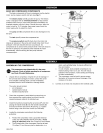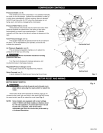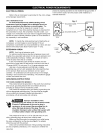
kvlv/-'1r,,1_II_[-e"]
RISK TO HEARING.
NOTE: ELECTRICAL WIRING.
Always wear hearing protection when using an air compressor. Failure to do so may result in
hearing loss.
The power cord on this product contains lead, a chemical known to the State of California to cause
cancer, and birth defects or other reproductive harm. Wash hands after handling.
Refer to the air compressor's serial label for the unit's voltage and amperage requirements. Ensure
[hat all wiring is done by a licensed electrician, in accordance with the National Electrical code.
Drain the moisture from the tank on a daily basis. A clean, dry tank will help prevent corrosion.
Pull the pressure relief valve ring daily to ensure that the valve is functioning properly, and to clear the valve of any possible
obstructions.
To provide proper ventilation for cooling, the compressor must be kept a minimum of 12 inches (31 cm) from the nearest wall, in a
vvell-ventilated area.
Fasten the compressor down securely if transporting is necessary. Pressure must be released from the tank before transporting.
Protect the air hose and electric cord from damage and puncture. Inspect them weekly for weak or worn spots, and replace if
necessary.
To reduce the risk of electric shock, do not expose to rain. Store indoors.
Never operate the compressor if the power cord or plug are damaged. Have the unit serviced at a Sears or other qualified service
center.
CFM
Cubic feet per minute; a unit of measure of air flow.
PSI
Pounds per square inch; a unit of measure of air pressure.
Kick-in pressure
Factory set low pressure point that starts the compressor to repressurize the tank to a higher pressure.
Kick-out pressure
Factory set high pressure point that stops the compressor from increasing the pressure in the tank above a certain level.
Well-ventilated
A means of providing fresh air in exchange for dangerous exhaust or vapors.
Dedicated circuit
An electrical circuit reserved for the exclusive use of the air compressor.
4 200-2792


















